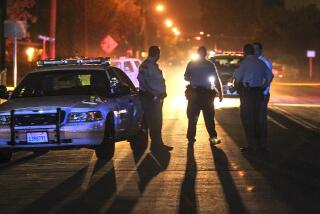Editorial: How to ensure impartial investigations of officers’ deadly force?
- Share via
How confident can we be that police departments do a fair and adequate job of investigating deadly encounters between their officers and the public? How confident can we be that district attorneys and grand juries act impartially when deciding whether to charge officers with crimes?
Much of the nationwide discussion that has taken place in the aftermath of the deaths of Michael Brown in Ferguson, Mo., Eric Garner in New York, Ezell Ford in Los Angeles — and other unarmed black men around the country — has begun to crystallize around those questions. One result is a push for independent investigations conducted not by the police department or the local prosecutor but by outsiders.
On Thursday, for example, the U.S. Conference of Mayors issued a report on police-community relations calling for, among other things, outside or independent investigators whenever a death occurs at the hands of a law enforcement officer. California Assemblyman Kevin McCarty (D-Sacramento) has introduced a bill — AB 86 — that would require the state Department of Justice to review fatal police shootings; local prosecutors would continue to decide whether to file charges. Candidates for the Los Angeles City Council have begun raising the issue, most notably in the 8th District. Ford was killed a block outside the district.
The focus on the adequacy of internal police investigations is welcome, as are the proposals for more independent probes. There is a crisis of confidence in policing, persistent through the decades but occasionally sharpening in response to high-profile deaths of the sort that made headlines last year, and felt especially in African American communities, where the relationship with law enforcement is strained by long and troubled histories of discrimination and violence. Independent investigations of fatal encounters with police, properly focused and sufficiently transparent, just might help.
But let’s not assume that they are the magic key to resolving the problem. There is a danger that the consensus of anti-police protest that has built up over the last six months will solidify around outside investigation before it becomes clear whether that would be workable or beneficial. And there is a danger that the law enforcement and union-based opposition to reform will build up a knee-jerk consensus against it.
Those tasked with examining the problem must deal with a threshold question: What are investigations into killings by police officers meant to resolve?
The police and the policed alike too often view the results of an internal or grand jury investigation in a binary way, conflating what ought to be distinct questions into one: Was the killing “good” or “bad”? That leaves people to conclude, in the event of a decision not to indict, as in the Brown and Garner cases, that the justice system or society as a whole has adjudged the killing to be justified.
The various layers of investigation are meant, instead, to ask at least three separate questions: (1) Did the officer commit a crime? (2) Did the officer violate policy? (3) Is the policy unjust or otherwise unsound?
Those fairly dry questions aren’t necessarily the ones that people ask after a police shooting. They want to know whether the officer who shot reasonably believed he was in danger; whether he was properly trained to defuse such a situation; whether he is racist, and is part of a racist system of law enforcement and justice. But any investigation, whether internal or independent, will have trouble with such subjective questions.
Prosecutors, grand juries, judges and trial juries determine whether an officer committed a crime, not whether a deadly encounter was handled properly from beginning to end. But investigations must tell us more than whether an officer is a callous murderer — a possibility, certainly, but a decreasingly likely circumstance in the 21st century. Policing today is a vexing issue precisely because society has changed and police hiring and patrolling practices have improved, but deadly encounters still occur far too frequently. Any investigation, regardless of who conducts it, must break down the question into its somewhat dry parts. Otherwise, the discussion over deadly police encounters may continue to produce far more heat than light.
Follow the Opinion section on Twitter @latimesopinion
More to Read
A cure for the common opinion
Get thought-provoking perspectives with our weekly newsletter.
You may occasionally receive promotional content from the Los Angeles Times.









